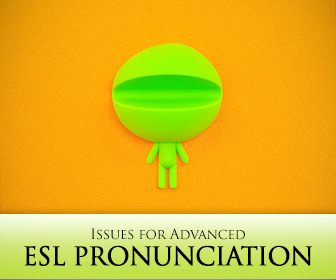Almost There, Continued Refinement: Issues for Advanced ESL Pronunciation


Well, their English is so good—fluent, correct, even precise—that you aren’t quite sure what to teach them! You suspect that many of them know English as well as you. That might actually be true in some areas for some students—having formally studied English for many years, they might have a more precise understanding of grammar, for example, than the teacher, who relies more on native-speaker intuition-- but there are still some things that most advanced students can learn in an ESL class.

Even fluent ESL students can usually use some work on their pronunciation. Have students do individual diagnostics by reading a passage while being taped. In this way, you can find common as well as individual concerns for the whole class. Focus on larger issues that might impede comprehensibility, such as faulty intonation patterns (such as failing to use rising intonation for questions) and stress (failing to reduce structure words and giving all words the same stress in a sentence). These are usually of more concern than relatively minor issues of individual speech sounds.
Focus on writing beyond the college essay, which the students may have been studying for years. Instead find out what careers students would like to hold after school, and focus on some of the writing they are likely to encounter in the workplace: memos, reports, analyses, and recommendations.
As with pronunciation, even fluent ESL students will differ from native speakers in issues of grammar and editing. Have students start a portfolio, analyze their own writing in terms of the corrections you make, and from this they can create an inventory of their personal trouble spots, which may include word endings, such as “-s” and “-ed.” Have students then get into the habit of trading papers with a peer and proofing for these errors or make two or three passes looking for the problem areas in their papers before handing them in.
Advanced ESL students often have good reading comprehension skills, especially at the surface level; what they often lack, however, is understanding inferences or the underlying meanings. These underlying meanings are critical to comprehension as a whole. For example, a story I like to teach for inferences is “Reunion,” by John Cheever, a story of no more than several pages in which a boy calls his estranged father and asks to meet him at Grand Central Station for lunch as he’s heading home, to his mother’s, for summer break. The father meets him at the station, proceeds to take him to several restaurants where he gets into arguments at each with the staff and gets kicked out; they return to the station so the boy can catch his train, the father now in tears. The boy vows never to see his father again as he boards the train. ESL students are invariably confused by the story and why the father acts as he does, while adult native speakers are usually aware of a number of implications: the father is drunk, was drunk when he met his son, gets more so as the afternoon wears on; he is an alcoholic, in fact, and the story makes a powerful statement on how substance abuse can destroy families.
Giving students a reading like this and discussing it—why is the father acting this way? Why does he keep going from restaurant to restaurant? — can help students spot these unstated suppositions and develop their inferential reading skills.
Even native speakers can struggle with academic listening and notetaking skills and must be trained in them. There are textbooks that build exercises around lectures from places like NPR, National Public Radio, on topics such as the ethics of stem cell research. I don’t advocate necessarily using such a text as the core text—few texts at this level can meet that role—but a chapter every week or two is a good supplement to the class. Or the instructor could also download a lecture from the web and develop her own exercises.
Even advanced ESL students can use some work on idiomatic language. This doesn’t mean the relatively rare “colorful” language such as “raining cats and dogs,” but the way that words tend to combine: “process cultivated over time,” “ongoing awareness,” and “insightful change of behavior” all occurred in one paragraph of an academic text opened at random. The class can spend some time each session or each week going over the idiomatic language that occurs in course reading.
Often ESL students need to develop their understanding of the everyday life and behavior of their new culture, often having lived here a short time and learned English somewhere else. Again, by “culture,” I don’t necessarily mean the big celebrations, like Thanksgiving, which students generally do learn about, but the everyday patterns of behavior that are so “minor” that they can go unnoticed. A Chinese student once expressed surprise, for example, that Americans, when exiting a building, generally turn back to see if anyone is behind and will hold the door if so. Similarly, recently a German student told me how shocked her husband was when, at a working lunch, an American colleague rose, went to the buffet table, came back with a plate of food, and continued with the meeting while eating. These behaviors may seem “natural” to most Americans (indeed, I am typing this article in a cafe, with a plate of food), and not worth discussing, but because people from other cultures are surprised by the behaviors, they are not “natural” but cultural. It is for this reason that novel habits students notice in their new countries should be discussion and writing topics.
Americans are notorious for their lack of understanding of their own history—fitting for a people obsessed with youth. But anyone who lives here should understand, for example, the Revolutionary War, the Civil War, the Civil Rights Movement and their long-term effects. Even relatively recent history, such as the Vietnam War, was a watershed event, creating a permanent distrust in leadership, among other effects. Without understanding the Vietnam War, it may be hard to understand contemporary American life.
Both film and books are ways to simultaneously develop language and cultural understanding. The Great Gatsby by F. Scott Fitzgerald, for example, is a powerful novel on the American experience and generally recognized as one of the great American novels. And it is also manageably short, at fewer than 200 pages. A new movie version is currently being made, so studying the book and then the film could be a core learning experience.
Finally, advanced ESL class is a great opportunity to work on resume and job interview skills. Some students are unfamiliar with the job hunt process, having come from cultures where people don’t compete for jobs as they do in the U.S. but rather are placed in them according to skill and education. Explaining the process, showing model resumes, and practicing interviews can be a big help to ESL students.
The key is to be selective and choose those topics most helpful to students in transitioning into university classes or the workplace. By focusing on improving pronunciation, reading, and writing skills and teaching students job search skills needed to move into the workplace, class days will be filled in no time.